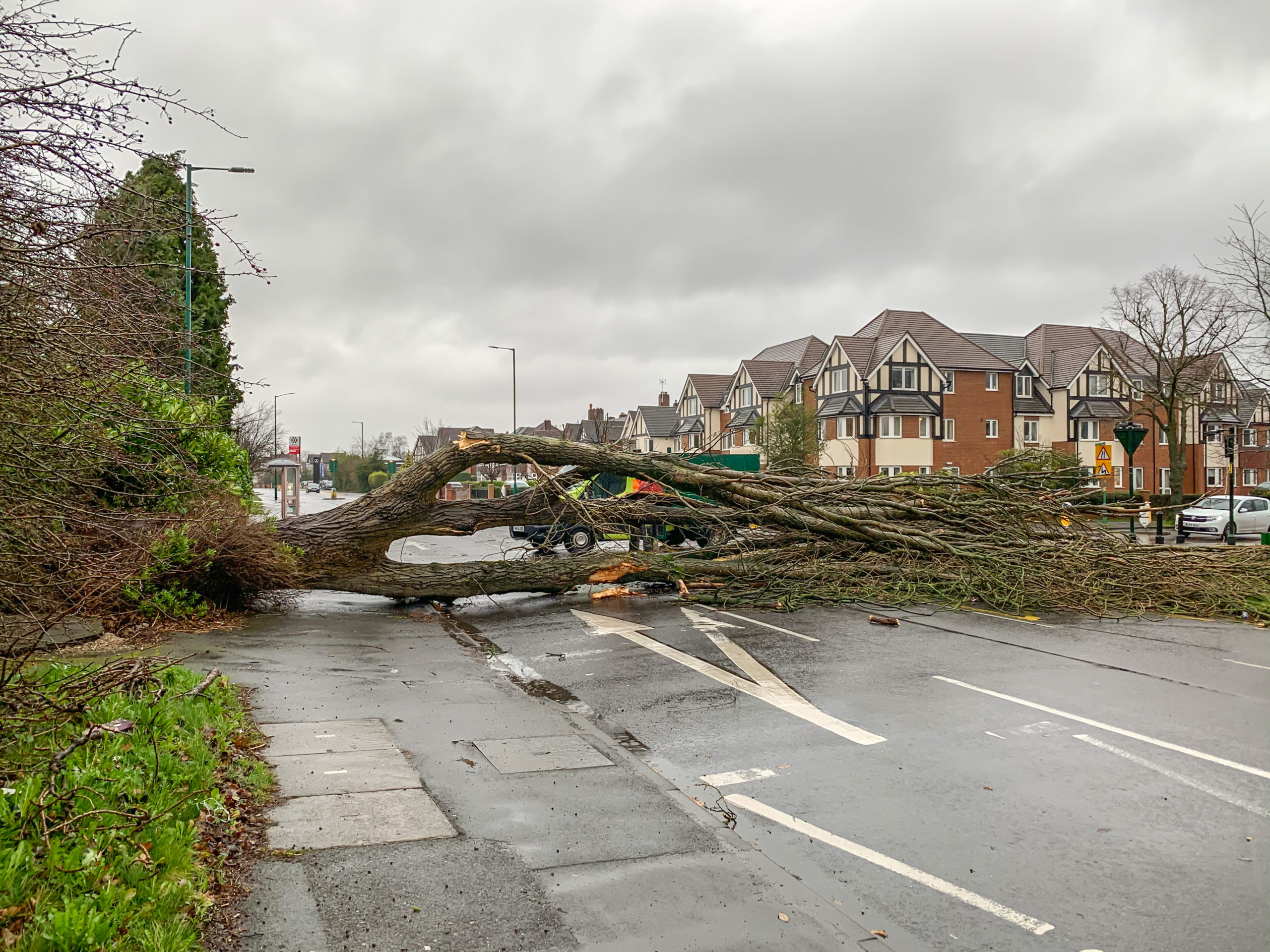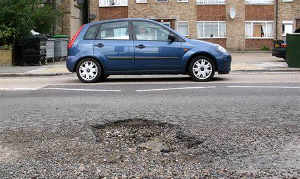Named storms bring jump in home insurance claims

7th December 2021
Dave Thompson, Director of Claims at Tesco Bank commented: “The first named storm of the winter has, unfortunately, hit the UK, disrupting thousands of people and leaving homes and gardens damaged up and down the country.
“As well as tackling any damage from the recent heavy winds people should be readying their homes and gardens for potentially more extreme weather this winter. There are a few steps we can all take to batten down the hatches and reduce the risk to our properties and belongings.”
Steps to take to keep your home and contents safe this winter
Secure garden equipment
In strong winds, outdoor furniture can be blown away and cause damage to your home. If possible, find a way to secure any garden furniture or objects that you think could cause damage. For example, large flower pots or trampolines have been known to roll and smash into windows. If you can’t lock them away in a shed, secure them in the most sheltered part of the garden, away from your home and bolt them down. You should also put any garden tools and equipment inside a garage, a shed, or in the house if needs be.
Trim back trees and bushes
Strong winds can easily send branches flying and they could wind up smashing your windows or damaging your car. Try to trim back any small trees or bushes surrounding your home to help minimise the chance of these being able to cause any damage.
Keep an eye on the roof
Check the roof for any damaged areas, or cracked lead flashing, that could let water into your home. You can do this safely from the ground and also keep a lookout for any loose tiles or slates, as they could easily be misplaced by strong winds.
If anything looks out of place, or doesn’t look right, the best move is to bring in a professional who can make any repairs needed.
Check your home insurance
To ensure your home and belongings have the protection needed, share all the information you can with your insurance provider.
Prepare for heavy rain
Storms can often bring periods of heavy rainfall and flooding.
If you are at an immediate risk of flooding, ensure you disconnect or switch off any electrical appliances as well as your gas and water supplies. Do not switch any of your electrical supplies back on until the flooding is over and they have been checked by a professional.
Floodwater can ruin your rugs, curtains and soft furnishings, so keep them out of harm’s way by storing them upstairs or as high up in your home as possible.
Water can also carry your furniture about your home and cause even more damage. Weigh down or secure all the pieces that are too heavy for you to move to try and prevent this from happening.
Store away valuables
Even if you have home and contents insurance that covers you for loss or damage of items in your home, some valuable and sentimental items simply cannot be replaced. To minimise the risk of these getting damaged, move all of your valuables upstairs, or into the loft if you have one and make sure any valuable items in your home are specified and covered, as this could help you replace them if needs be. You should also put any important documentation into plastic bags and find a place to store them.
What to do if your home has been damaged by a storm
Make sure your home is safe
If your home has been badly hit, make sure it is safe before you return. If you are unsure seek the support of experts like your local electricity supplier or the National Grid who can inspect your property and confirm it is safe to enter.
Contact your insurer
If your home or any of your contents have been damaged by Storm Arwen, don’t wait to contact your insurer. Speak to them about what has happened and they can advise on the next steps to take.
Take photographs
Make sure you document any damage to your home. Take photographs on your phone, this will mean you can share them with your insurer if they need them.
Make a list
Make a full list of the damage caused by the storm. Carry out a full check of the exterior and interior of your home to make sure you’ve spotted everything.
Keep damaged items
If possible, resist the urge to throw away damaged items. Keeping hold of them means you can show the insurance inspectors when they come to view your property.
Dave Thompson, Director of Claims at Tesco Bank commented: “The first named storm of the winter has unfortunately hit the UK, disrupting thousands of people and leaving homes and gardens damaged up and down the country.
“As well as tackling any damage from the recent heavy winds people should be readying their homes and gardens for potentially more extreme weather this winter. There are a few steps we can all take to batten down the hatches and reduce the risk to our properties and belongings.”
Steps to take to keep your home and contents safe this winter
Secure garden equipment
In strong winds, outdoor furniture can be blown away and cause damage to your home. If possible, find a way to secure any garden furniture or objects that you think could cause damage. For example, large flower pots or trampolines have been known to roll and smash into windows. If you can’t lock them away in a shed, secure them in the most sheltered part of the garden, away from your home and bolt them down. You should also put any garden tools and equipment inside a garage, a shed, or in the house if needs be.
Trim back trees and bushes
Strong winds can easily send branches flying and they could wind up smashing your windows or damaging your car. Try to trim back any small trees or bushes surrounding your home to help minimise the chance of these being able to cause any damage.
Keep an eye on the roof
Check the roof for any damaged areas, or cracked lead flashing, that could let water into your home. You can do this safely from the ground and also keep a lookout for any loose tiles or slates, as they could easily be misplaced by strong winds.
If anything looks out of place, or doesn’t look right, the best move is to bring in a professional who can make any repairs needed.
Check your home insurance
To ensure your home and belongings have the protection needed, share all the information you can with your insurance provider.
Prepare for heavy rain
Storms can often bring periods of heavy rainfall and flooding.
If you are at an immediate risk of flooding, ensure you disconnect or switch off any electrical appliances as well as your gas and water supplies. Do not switch any of your electrical supplies back on until the flooding is over and they have been checked by a professional.
Floodwater can ruin your rugs, curtains and soft furnishings, so keep them out of harm’s way by storing them upstairs or as high up in your home as possible.
Water can also carry your furniture about your home and cause even more damage. Weigh down or secure all the pieces that are too heavy for you to move to try and prevent this from happening.
Store away valuables
Even if you have home and contents insurance that covers you for loss or damage of items in your home, some valuable and sentimental items simply cannot be replaced. To minimise the risk of these getting damaged, move all of your valuables upstairs, or into the loft if you have one and make sure any valuable items in your home are specified and covered, as this could help you replace them if needs be. You should also put any important documentation into plastic bags and find a place to store them.
What to do if your home has been damaged by a storm
Make sure your home is safe
If your home has been badly hit, make sure it is safe before you return. If you are unsure seek the support of experts like your local electricity supplier or the National Grid who can inspect your property and confirm it is safe to enter.
Contact your insurer
If your home or any of your contents have been damaged by Storm Arwen, don’t wait to contact your insurer. Speak to them about what has happened and they can advise on the next steps to take.
Take photographs
Make sure you document any damage to your home. Take photographs on your phone, this will mean you can share them with your insurer if they need them.
Make a list
Make a full list of the damage caused by the storm. Carry out a full check of the exterior and interior of your home to make sure you’ve spotted everything.
Keep damaged items
If possible, resist the urge to throw away damaged items. Keeping hold of them means you can show the insurance inspectors when they come to view your property.





